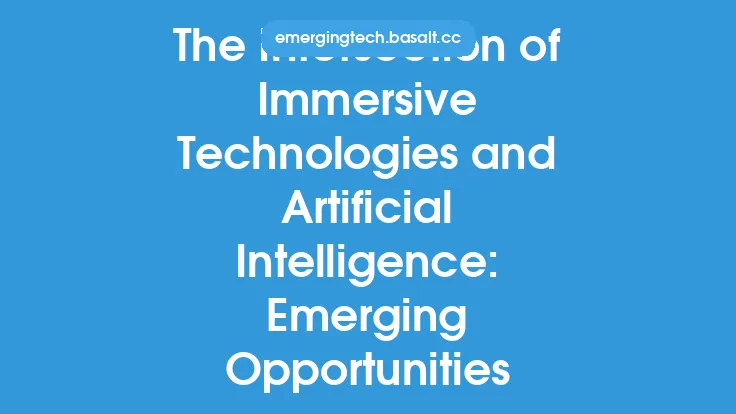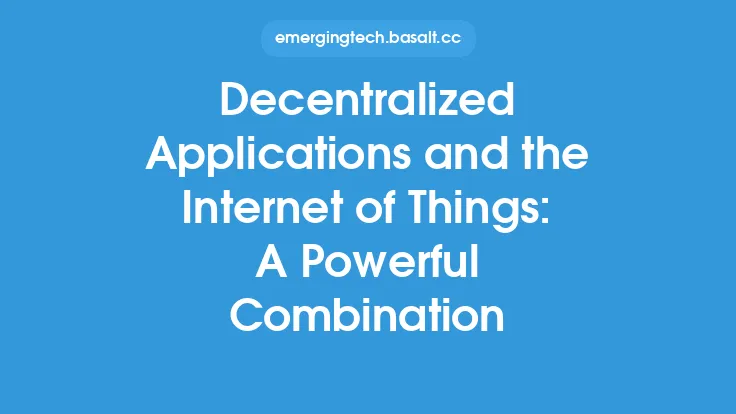The emergence of artificial intelligence (AI) and decentralized applications (dApps) has sparked a new wave of innovation in the tech industry. As these two technologies continue to evolve, their intersection is becoming increasingly important, enabling the creation of more sophisticated, secure, and transparent digital systems. In this article, we will delve into the world of AI and dApps, exploring their individual concepts, benefits, and challenges, as well as the exciting possibilities that arise when they are combined.
Introduction to Artificial Intelligence
Artificial intelligence refers to the development of computer systems that can perform tasks that typically require human intelligence, such as learning, problem-solving, and decision-making. AI has been around for decades, but recent advancements in machine learning and deep learning have enabled the creation of more complex and capable AI systems. These systems can analyze vast amounts of data, identify patterns, and make predictions or recommendations, making them incredibly useful in a wide range of applications, from virtual assistants to medical diagnosis.
Introduction to Decentralized Applications
Decentralized applications, on the other hand, are software programs that run on a decentralized network, such as a blockchain. Unlike traditional applications, which are controlled by a single entity and rely on centralized servers, dApps are open-source, community-driven, and operate on a peer-to-peer network. This decentralized architecture provides several benefits, including increased security, transparency, and censorship resistance. dApps can be used for a variety of purposes, such as social media, gaming, and finance, and have the potential to disrupt traditional industries and create new opportunities for innovation.
The Intersection of AI and Decentralized Applications
When AI and dApps are combined, the possibilities are endless. By leveraging the power of AI, dApps can become more intelligent, autonomous, and adaptive, enabling them to make decisions and take actions without human intervention. For example, a decentralized finance (DeFi) dApp could use AI to analyze market trends and make predictions about future price movements, allowing users to make more informed investment decisions. Similarly, a social media dApp could use AI to personalize content recommendations, detect and prevent harassment, and improve user engagement.
Benefits of AI-Powered Decentralized Applications
The integration of AI and dApps offers several benefits, including:
- Improved security: AI-powered dApps can detect and respond to security threats in real-time, reducing the risk of hacking and other malicious activities.
- Enhanced user experience: AI can be used to personalize the user experience, providing tailored recommendations and improving overall engagement.
- Increased efficiency: AI-powered dApps can automate routine tasks, freeing up resources and improving overall efficiency.
- Greater transparency: AI can be used to analyze and provide insights into dApp activity, promoting transparency and trust within the community.
Challenges and Limitations
While the intersection of AI and dApps holds great promise, there are also several challenges and limitations to consider. These include:
- Scalability: AI-powered dApps require significant computational resources, which can be a challenge in decentralized networks where resources are limited.
- Data quality: AI algorithms require high-quality data to function effectively, which can be a challenge in decentralized systems where data is often fragmented and inconsistent.
- Regulation: The use of AI in dApps raises regulatory concerns, particularly with regards to issues like bias, fairness, and transparency.
Real-World Applications
Despite the challenges, there are already several real-world applications of AI-powered dApps. These include:
- Predictive maintenance: AI-powered dApps can be used to predict and prevent equipment failures in industries like manufacturing and logistics.
- Supply chain management: AI-powered dApps can be used to optimize supply chain operations, improving efficiency and reducing costs.
- Healthcare: AI-powered dApps can be used to analyze medical data, provide personalized recommendations, and improve patient outcomes.
Future Directions
As the intersection of AI and dApps continues to evolve, we can expect to see new and innovative applications emerge. Some potential future directions include:
- Decentralized autonomous organizations (DAOs): AI-powered dApps could be used to create decentralized autonomous organizations, which can make decisions and take actions without human intervention.
- Artificial general intelligence (AGI): The development of AGI could enable the creation of more sophisticated AI-powered dApps, which can perform a wide range of tasks and adapt to new situations.
- Edge AI: The integration of AI and edge computing could enable the creation of more efficient and effective AI-powered dApps, which can operate in real-time and respond to changing conditions.
Conclusion
The intersection of AI and dApps is a rapidly evolving field, with significant potential for innovation and disruption. By leveraging the power of AI, dApps can become more intelligent, autonomous, and adaptive, enabling them to make decisions and take actions without human intervention. While there are challenges and limitations to consider, the benefits of AI-powered dApps are clear, and we can expect to see new and exciting applications emerge in the years to come. As the technology continues to evolve, it will be important to address the challenges and limitations, and to ensure that the development of AI-powered dApps is aligned with human values and promotes a more secure, transparent, and equitable digital world.





